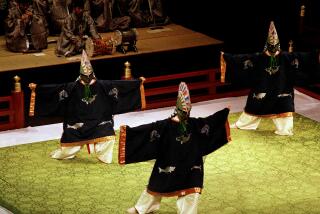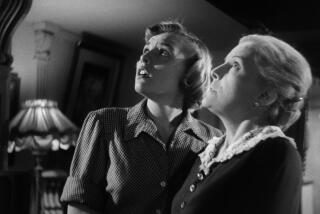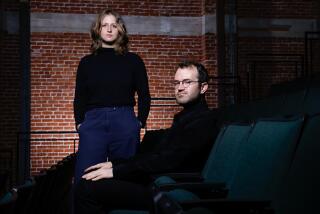A Bounty of Rescued Celluloid : Movies: The 1924 ‘Sea Hawk’ launches UCLA’s monthlong Festival of Preservation tonight. Gems from international archives are featured.
If you think you care about movies, the just-completed fuss about the Oscars is the high point of the year. If you want other people to think you care, the AFI’s Los Angeles International Film Festival is the hot ticket. But if you really are passionate, tonight marks the beginning of the most exciting event of the cinematic calendar, UCLA’s monthlong Festival of Preservation.
Starting with this evening’s 7:30 p.m. Melnitz Hall screening of the 1924 silent blockbuster “The Sea Hawk,” the UCLA fest presents 23 separate programs, including restored examples from some gloriously odd and curious corners of cinema in as close to mint condition as anyone is ever going to see.
Not that UCLA is obsessed with the obscure. Just as important, this Festival of Preservation, the sixth annual, is an opportunity to see such familiar classics as “Mr. Smith Goes to Washington” (April 16), the Busby Berkeley-choreographed “42nd Street” (April 23), Warren Beatty in Arthur Penn’s cult favorite “Mickey One” (April 30) and a splendid Marlon Brando double-bill of “The Wild One” and “The Men” (May 1), all on the big screen where they belong.
The theme of this year’s festival, especially appropriate after the fuss the GATT agreement stirred up about international competition, is a tribute to overseas archives, a tip of the hat to institutions in France, Great Britain, Denmark, the Netherlands and the Czech Republic, all of which have helped save and preserve American films. Tonight’s opener, “The Sea Hawk,” starring a heroic Milton Sills and based on the swashbuckling Rafael Sabatini novel, was especially in need of foreign aid. The best American print, in the Library of Congress, was missing most of the film’s extraordinary battle scenes, filmed with life-size replicas--not models--and so good that Warner Bros. repeatedly cannibalized them for use in later nautical epics. The missing footage was pieced together (with Turner Broadcasting money) from holdings of both the Czech archive and Moscow’s Gosfilmofond as well as an assiduous private collector.
Was all this trouble worth it? Absolutely. The story of how a 16th-Century English lord named Oliver embraced Islam and became Sakr-el-Bahr, the scourge of Christianity whose soul was “a caldron of smoldering hate,” this tumultuous epic (enhanced by Robert Israel at the organ) made excellent use of its thousands of extras and the hard-working Sills and became one of the most popular films of the 1920s. What an impressed Daily Variety critic said at the time still holds true: “There isn’t a thing lacking in this picture that any film fan could want.”
Another silent figure, even more fondly remembered than Sills, also benefited from dramatically rediscovered footage. Tom Mix, the hard-riding, straight-shooting but always good-humored cowboy hero of hundreds of Westerns (and whose genuine 10-gallon hat makes him look like a progenitor of the Coneheads), will be the focus of an April 24 matinee.
In addition to “The Texan,” showing will be the 1916 short “Taking a Chance,” found in the dismal basement of a Danish tavern where Peter the Great once spent the night, and “The Last of the Duanes,” a 1924 feature discovered under layers of bird excrement on the floor of a remote Czech chicken farm. Film preservation is obviously not for the faint of heart.
This year’s festival also does well by films from the early days of talking pictures with a Tuesday double bill of “Lucky Boy” and “Applause.” The later, a singular combination of naturalism and heartbreak directed by Rouben Mamoulian, is easily the better-known work, a landmark in the inventive use of sound that stars legendary torch singer Helen Morgan as a burlesque queen who wants to save her daughter from the same dread fate.
*
“Lucky Boy,” starring Georgie Jessel as a character named Georgie Jessel, a Bronx jeweler’s son with a yen for show business, is fascinating in its own right. Part sound, part silent, it brazenly echoes “The Jazz Singer,” the play Jessel starred in on Broadway but avoided on film. And besides Jessel singing endless choruses of “My Mother’s Eyes,” it also features unapologetically ethnic humor: Describing a new car from anti-Semite Henry Ford, Jessel insists that “if you speak Yiddish in the back seat, it stops immediately.”
Also a pioneering effort, but in a different field, was the 1934 short “La Cucaracha” (April 24). The first live-action three-strip Technicolor item (which led directly to “Becky Sharp,” the first three-strip feature), “La Cucaracha’s” silly plot about rival Mexican dancers offers opportunities for some of the most intoxicating color work, featuring shades of pastel that are dizzying. Also, the film provides the original, unexpurgated version of the lyrics of that famous song, referring gaily to the smoking of marijuana cigarettes.
On the same bill as “La Cucaracha” and equally notable for the frankness of its dialogue and situations is “The Animal Kingdom,” a sophisticated pre-Hays Code drama based on a play by Philip Barry, better known for “Holiday” and “The Philadelphia Story.”
Starring Leslie Howard as a gentleman publisher in Connecticut whose impending marriage to Myrna Loy breaks up an intimate relationship with free-thinking illustrator Ann Harding, “Kingdom” was quite the adult drama, complete with such lines as “A foolish virgin, me--well, foolish anyway” that would quite shortly become taboo.
No preservation festival would be complete without its curiosities. Films like “Murder in Trinidad” (Sunday), a diverting programmer whose restoration was funded by mystery buff Hugh Hefner. In it Nigel Bruce, who endlessly played Watson to Basil Rathbone’s Holmes, finally gets to solve a crime on his own as Bertram Lynch, a fumbling Columbo prototype known as Old Hippo to his friends, who hangs out with a pet monkey and is not nearly as dense as he seems.
Perhaps the strangest film of the entire festival is the 1933 Cecil B. DeMille directed “This Day and Age” (Saturday). In this socially conscious drama, high school students fed up with the way the courts coddle criminals take the law into their own hands and kidnap a mobster to stand trial in front of a torch-lit kangaroo court. DeMille’s apparent fascination with vigilante justice has unsettling reverberations even today.
One of the festival’s most pleasant traditions is a program of newsreels, courtesy of the archive’s huge Hearst Metrotone News collection. Last year’s program featured ever-popular Zeppelin footage, and the only way to top that was this year’s choice material on Hollywood and show business itself.
Highlights of the April 14 program are outtakes from Oscar ceremonies, unguarded open mike moments that feature Bette Davis chatting with Wallace Beery and extra-hammy presenter D. W. Griffith in 1935, and a long excerpt from Greer Garson’s celebrated extra-long acceptance speech of 1942--moments any film buff will treasure and the purest example of what the festival is all about.
* The Festival of Preservation is held at Melnitz Hall on the northeast corner of the UCLA campus near Sunset Boulevard and Hilgard Avenue in Westwood. Admission is $5 and $3 for 7:30 p.m. screenings and $3 and $1.50 for 2 p.m. matinees. Parking available for $5. Information: (310) 206-FILM or 206-8013.
More to Read
Only good movies
Get the Indie Focus newsletter, Mark Olsen's weekly guide to the world of cinema.
You may occasionally receive promotional content from the Los Angeles Times.











